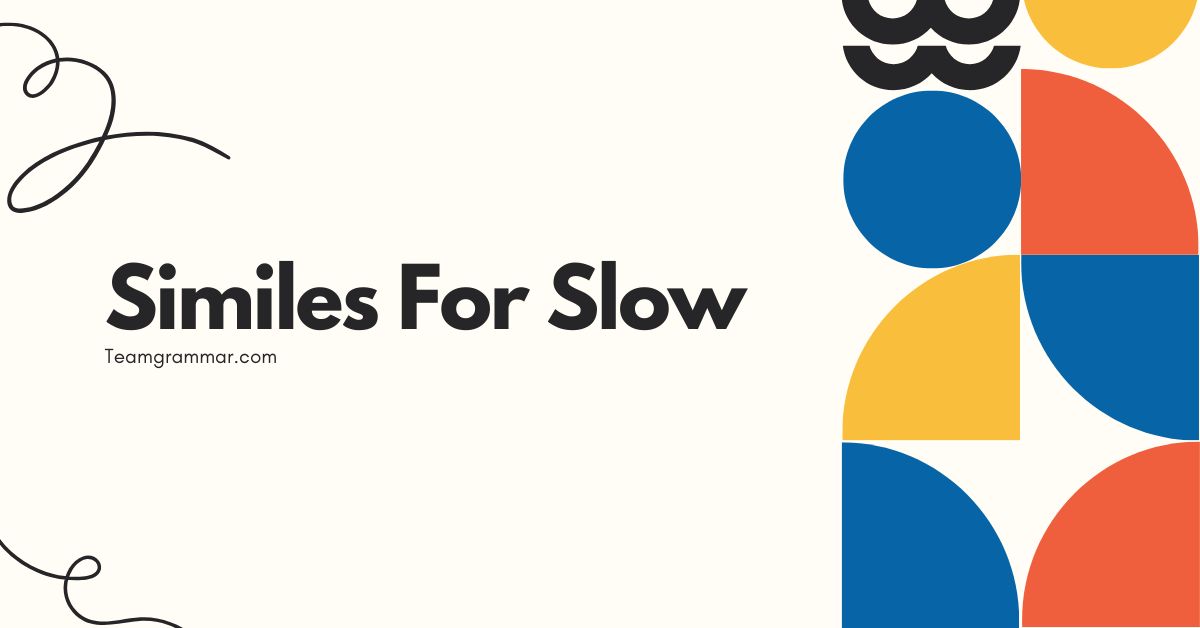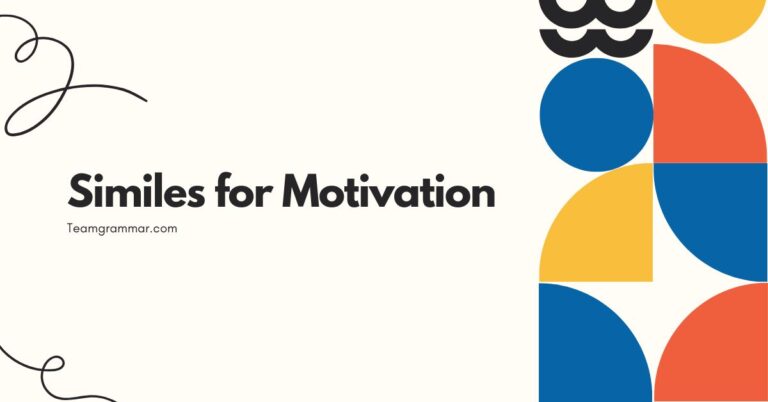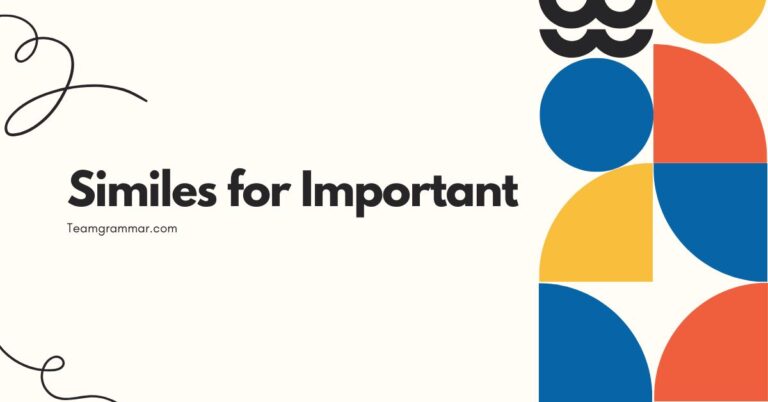45 Similes For Slow: Mastering Figurative Language
Understanding similes is crucial for enhancing your descriptive writing and comprehension skills. Similes, a type of figurative language, allow us to create vivid comparisons between two unlike things using words like “like” or “as.” This article focuses specifically on similes that describe slowness, offering a comprehensive guide for English learners of all levels.
By exploring various examples, structural patterns, and practical exercises, you’ll gain the ability to effectively use similes to depict slow movement, progress, or action. This knowledge will not only improve your writing but also deepen your understanding of nuanced communication in English.
This article is designed for anyone looking to refine their understanding of figurative language, particularly similes related to the concept of “slow.” Whether you are a student, a writer, or simply an English enthusiast, the insights and exercises provided here will empower you to use similes more confidently and creatively. From basic definitions to advanced applications, we’ll cover everything you need to master the art of crafting compelling similes for “slow.”
Table of Contents
- Definition of a Simile
- Structural Breakdown of Similes
- Types of Similes for Slow
- Examples of Similes for Slow
- Usage Rules for Similes
- Common Mistakes with Similes
- Practice Exercises
- Advanced Topics in Similes
- Frequently Asked Questions
- Conclusion
Definition of a Simile
A simile is a figure of speech that compares two unlike things using the words “like” or “as.” The primary function of a simile is to create a vivid image or convey a specific quality by associating it with something familiar. Similes are widely used in literature, poetry, and everyday conversation to add depth and color to language.
They help to make descriptions more engaging and relatable by drawing parallels between different concepts or objects.
In the context of describing slowness, similes help to illustrate the degree or nature of the slowness. For instance, saying something is “as slow as molasses” immediately paints a picture of something moving very deliberately and sluggishly.
This is more evocative than simply stating that something is “slow.” Similes leverage the reader’s existing knowledge and associations to create a more impactful and memorable impression.
Classification of Similes
Similes are classified as a type of figurative language, specifically under the category of comparisons. Other types of comparisons include metaphors, analogies, and personification, but similes are unique in their explicit use of “like” or “as.” This direct comparison distinguishes them from metaphors, which imply a comparison without using these words.
Function of Similes
The main function of a simile is to enhance understanding and create vivid imagery. By comparing something abstract or unfamiliar to something concrete and familiar, similes make complex ideas more accessible.
They also add emotional weight to descriptions, making them more impactful and memorable. In the context of describing “slow,” similes can convey not just the speed but also the feeling or consequence of being slow.
Contexts for Using Similes
Similes are appropriate in a wide range of contexts, from formal writing to casual conversation. In creative writing, they can enrich descriptions and add depth to characters and settings.
In persuasive writing, they can make arguments more relatable and convincing. In everyday speech, they can add humor and personality to your communication.
The key is to choose similes that are appropriate for your audience and purpose.
Structural Breakdown of Similes
A simile typically consists of two main components: the subject being described (the tenor) and the object it is being compared to (the vehicle). These two components are connected by the words “like” or “as,” which indicate the comparison.
Understanding the structure of a simile is essential for creating effective and meaningful comparisons.
The underlying structure is quite simple:Subject + “like” or “as” + Object. The subject is what you are describing, and the object is what you are comparing it to.
For example, in the simile “as slow as a snail,” the subject is something that is slow, and the object is a snail. The word “as” connects the two, indicating that the subject shares the quality of slowness with a snail.
Patterns of Similes
Several patterns can be observed in the construction of similes. One common pattern is to use “as” followed by an adjective and then “as” again, such as “as slow as molasses.” Another pattern is to use “like” followed by a noun phrase, such as “slow like a turtle.” The choice of pattern depends on the specific effect you want to achieve.
Rules of Similes
While similes are generally flexible, there are a few guidelines to keep in mind. First, the two things being compared should be genuinely different.
Comparing two things that are already very similar is not an effective use of a simile. Second, the comparison should be meaningful and relevant.
The shared quality should be clear and contribute to the overall description. Finally, avoid clichés.
Overused similes can sound stale and unoriginal.
Types of Similes for Slow
Similes for “slow” can be categorized based on the specific aspect of slowness they emphasize. Some similes focus on the deliberate pace, while others highlight the lack of speed or the difficulty of movement.
Understanding these different types can help you choose the most appropriate simile for your needs.
Similes Emphasizing Deliberate Pace
These similes suggest that the slowness is intentional and measured. They often evoke a sense of calmness or carefulness.
Examples include “as slow as a monk in meditation” or “like a tortoise crossing the road.” These similes are useful when you want to convey a sense of purpose or control behind the slowness.
Similes Highlighting Lack of Speed
These similes emphasize the absence of speed or progress. They often convey a sense of frustration or stagnation.
Examples include “as slow as dial-up internet” or “like watching paint dry.” These similes are effective when you want to express impatience or dissatisfaction with the slowness.
Similes Describing Difficult Movement
These similes focus on the effort or obstacles involved in the slow movement. They often suggest that the slowness is due to some external factor or internal struggle.
Examples include “as slow as wading through mud” or “like a rusty cog turning.” These similes are useful when you want to convey a sense of hardship or resistance.
Examples of Similes for Slow
Here are numerous examples of similes that describe slowness, categorized to illustrate their diverse applications. The tables below provide a range of options to enhance your writing and communication.
Similes Focusing on Natural Objects
This table presents similes that use natural objects to describe slowness. These comparisons often evoke a sense of tranquility or inevitability.
| Simile | Explanation |
|---|---|
| As slow as a snail | Snails are known for their deliberate and unhurried pace. |
| Like a tortoise | Tortoises are symbols of longevity and slow, steady progress. |
| As slow as molasses in January | Molasses becomes very thick and slow-moving in cold temperatures. |
| Like a glacier moving | Glaciers move imperceptibly slowly over long periods. |
| As slow as a sloth | Sloths are known for their extremely slow movements and metabolism. |
| Like sap flowing in winter | Tree sap flows very slowly during the winter months. |
| As slow as a caterpillar crawling | Caterpillars move slowly and deliberately as they crawl. |
| Like a stone rolling uphill | Implies difficulty and slow progress against resistance. |
| As slow as lichen growing | Lichen grows extremely slowly, often taking years to cover a small area. |
| Like a spider spinning its web | The process of spinning a web is intricate and time-consuming. |
| As slow as sediment settling | The process of sediment settling in water is gradual and unhurried. |
| Like a turtle crossing a highway | Highlights the vulnerability and slowness of the turtle. |
| As slow as dew forming | The formation of dew is a gradual and almost imperceptible process. |
| Like coral growing on a reef | Coral growth is a very slow process, measured in millimeters per year. |
| As slow as a tree growing | The growth of a tree is a gradual process that takes many years. |
| Like a snail leaving a trail | Highlights the slow and deliberate movement of a snail. |
| As slow as watching the grass grow | Emphasizes the boredom and tedium of waiting for something to happen slowly. |
| Like a river meandering | Rivers often take a winding and slow path. |
| As slow as a shadow creeping | Shadows move gradually as the sun moves across the sky. |
| Like a leaf falling in autumn | Leaves fall slowly and gracefully from trees in autumn. |
| As slow as sap rising in spring | While sap rising signals renewal, it’s a gradual and deliberate process. |
| Like a mountain eroding | Erosion is a slow and gradual process that shapes mountains over time. |
| As slow as a vine climbing | Vines climb gradually, often taking weeks or months to reach their full height. |
Similes Focusing on Human Activities
This table features similes that use human activities to illustrate slowness. These comparisons often relate to tasks that are tedious or require patience.
| Simile | Explanation |
|---|---|
| As slow as watching paint dry | This simile emphasizes the boredom and tedium of waiting for something to happen. |
| Like waiting for water to boil | Highlights the impatience and anticipation while waiting. |
| As slow as a week in school | Captures the feeling of time dragging on during a long week. |
| Like wading through mud | Suggests difficulty and slow progress in a challenging situation. |
| As slow as untangling Christmas lights | Emphasizes the frustration and time-consuming nature of the task. |
| Like reading a long, boring book | Highlights the tedium and lack of engagement. |
| As slow as a computer booting up | Relates to the often frustratingly slow process of starting a computer. |
| Like a rusty cog turning | Implies difficulty and resistance in a mechanical process. |
| As slow as a government bureaucracy | Refers to the often slow and complex processes of government organizations. |
| Like a dial-up modem connecting | Evokes the slow and noisy process of connecting to the internet in the past. |
| As slow as handwriting a novel | Highlights the time-consuming and laborious nature of writing by hand. |
| Like listening to a lecture on economics | Emphasizes the boredom and complexity of the subject matter. |
| As slow as teaching a cat to fetch | Highlights the difficulty and lack of progress in a challenging task. |
| Like trying to solve a Rubik’s Cube | Suggests the complexity and time-consuming nature of the puzzle. |
| As slow as navigating a maze blindfolded | Emphasizes the difficulty and uncertainty of the situation. |
| Like watching a chess game between beginners | Highlights the slow pace and lack of skill in the game. |
| As slow as learning a new language | Refers to the gradual and challenging process of language acquisition. |
| Like waiting in line at the DMV | Evokes the frustration and tedium of waiting in a long line. |
| As slow as reading the dictionary | Highlights the lack of excitement and engagement in the task. |
| Like watching a parade in slow motion | Emphasizes the deliberate and unhurried pace of the event. |
| As slow as explaining something to a child | Highlights the patience and repetition required in the explanation. |
| Like writing a letter with a quill pen | Evokes the traditional and time-consuming method of writing. |
| As slow as listening to a vinyl record | Refers to the slower pace and analog nature of vinyl records. |
Similes Focusing on Animals
This table presents similes that use animals to describe slowness. These comparisons often evoke a sense of gentleness or lack of urgency.
| Simile | Explanation |
|---|---|
| As slow as a turtle | Turtles are known for their slow and steady pace. |
| Like a snail’s pace | Snails are among the slowest creatures, emphasizing minimal progress. |
| As slow as a sloth climbing | Sloths are famously slow-moving, highlighting extreme slowness. |
| Like a worm inching forward | Worms move very slowly, emphasizing incremental progress. |
| As slow as a three-toed sloth | Highlights the specific slowness of the three-toed sloth. |
| Like a tortoise crossing the desert | Implies a slow and arduous journey. |
| As slow as a caterpillar moving | Emphasizes the deliberate and unhurried pace of a caterpillar. |
| Like a tired dog dragging its feet | Suggests a lack of energy and enthusiasm. |
| As slow as a herd of turtles migrating | Highlights the collective slowness of a group of turtles. |
| Like a snail leaving a silver trail | The trail emphasizes the slow and deliberate movement. |
| As slow as a spider crawling up a wall | Highlights the slow and methodical movement of the spider. |
| Like a slug making its way through the garden | Emphasizes the slow and slimy nature of the slug’s movement. |
| As slow as a tired snail climbing a leaf | Suggests exhaustion and slow progress. |
| Like a tortoise winning a race | Emphasizes the unlikelihood of speed and the certainty of slowness. |
| As slow as a caterpillar building a cocoon | Highlights the gradual and time-consuming process. |
| Like a snail carrying its shell | The shell emphasizes the burden and slowness. |
| As slow as a worm burrowing through the earth | Highlights the effort and time required for the task. |
| Like a snail inching across a windowpane | Emphasizes the slow and deliberate movement. |
| As slow as a tortoise eating lettuce | Highlights the gentle and unhurried nature of the action. |
| Like a snail exploring a garden | Emphasizes the slow and deliberate exploration. |
| As slow as a slug on a summer’s day | Highlights the languid pace and warmth of summer. |
| Like a caterpillar munching on a leaf | Emphasizes the slow and steady consumption. |
| As slow as a tortoise sunbathing | Highlights the relaxed and unhurried nature of the activity. |
| Like a snail sliding down a leaf | Emphasizes the slow and gentle descent. |
Usage Rules for Similes
Using similes effectively requires an understanding of the rules that govern their proper use. While similes are a creative tool, adhering to certain guidelines ensures clarity and impact.
Avoid clichés, ensure relevance, and consider your audience when crafting similes.
Avoiding Clichés
Clichés are overused similes that have lost their impact through repetition. Examples include “as slow as molasses” (while effective, it’s very common) or “like watching paint dry.” To avoid clichés, strive for originality and creativity in your comparisons.
Think of fresh and unexpected ways to describe slowness.
Ensuring Relevance
The comparison in a simile should be relevant and meaningful. The shared quality between the subject and the object should be clear and contribute to the overall description.
Avoid making comparisons that are arbitrary or confusing. The reader should immediately understand the connection between the two things being compared.
Considering Your Audience
The effectiveness of a simile depends on your audience’s understanding and associations. Choose comparisons that are familiar and relatable to your readers.
Avoid using obscure references or technical terms that might not be widely understood. Tailor your similes to the specific knowledge and background of your audience.
Common Mistakes with Similes
Even experienced writers can make mistakes when using similes. Common errors include confusing similes with metaphors, using illogical comparisons, and creating mixed metaphors.
Being aware of these pitfalls can help you avoid them.
Simile vs. Metaphor
The key difference between a simile and a metaphor is the use of “like” or “as.” A simile makes an explicit comparison, while a metaphor implies a comparison without using these words. Confusing the two can lead to grammatical errors and unclear writing.
For example:
- Incorrect (Metaphor as Simile): “He is a snail, as slow.”
- Correct (Simile): “He is as slow as a snail.”
- Correct (Metaphor): “He is a snail when it comes to getting things done.”
Illogical Comparisons
An illogical comparison occurs when the shared quality between the subject and the object is not clear or relevant. This can lead to confusion and weaken the impact of the simile.
For example:
- Incorrect: “The car was as slow as a rocket.” (Rockets are fast, not slow.)
- Correct: “The car was as slow as a horse-drawn carriage.”
Mixed Metaphors
A mixed metaphor combines two or more incompatible metaphors or similes, creating a nonsensical image. While this is more of a metaphor issue, similes can contribute.
For example:
- Incorrect: “He was as slow as a snail running a marathon.” (Snails don’t run marathons.)
- Correct: “He was as slow as a snail.”
Practice Exercises
Test your understanding of similes with these practice exercises. Choose the best simile to complete each sentence, or create your own simile based on the given prompt.
Exercise 1: Completing Sentences
Choose the best simile to complete each sentence.
| Question | Options | Answer |
|---|---|---|
| The old computer was ___________. | a) as fast as lightning, b) as slow as molasses, c) like a race car | b) as slow as molasses |
| His progress on the project was ___________. | a) like a rocket taking off, b) as slow as a snail, c) as quick as a bunny | b) as slow as a snail |
| The traffic moved ___________. | a) as fast as a cheetah, b) like a turtle crossing the road, c) as quick as a wink | b) like a turtle crossing the road |
| The lecture seemed to go ___________. | a) as fast as a rollercoaster, b) as slow as watching paint dry, c) like a bullet | b) as slow as watching paint dry |
| The river flowed ___________. | a) as swift as an arrow, b) as slow as a glacier moving, c) like a waterfall | b) as slow as a glacier moving |
| The old printer printed ___________. | a) like a speeding train, b) as slow as a tired snail, c) as quick as a flash | b) as slow as a tired snail |
| The negotiations proceeded ___________. | a) like a whirlwind, b) as slow as a government bureaucracy, c) as fast as a jet | b) as slow as a government bureaucracy |
| The student learned the material ___________. | a) as quickly as a sponge absorbs water, b) as slow as a tortoise, c) like a rocket | b) as slow as a tortoise |
| The clock ticked ___________. | a) as fast as a hummingbird’s wings, b) as slow as eternity, c) like a race | b) as slow as eternity |
| The process was ___________. | a) as efficient as a machine, b) as slow as wading through mud, c) like a breeze | b) as slow as wading through mud |
Exercise 2: Creating Similes
Create your own simile to describe each situation.
| Situation | Your Simile |
|---|---|
| Describing a very slow internet connection. | As slow as dial-up in the modern age. |
| Describing someone who takes a long time to make a decision. | Like a snail trying to decide which leaf to eat. |
| Describing a project that is progressing very slowly. | As slow as a glacier carving a valley. |
| Describing the pace of a boring meeting. | Like watching paint dry in slow motion. |
| Describing the movement of a very old person. | As slow as a tortoise climbing a hill. |
| Describing the responsiveness of an outdated system. | Like waiting for a response from a carrier pigeon. |
| Describing the speed of a complicated legal process. | As slow as a bill making its way through Congress. |
| Describing the progress of a difficult learning curve. | Like climbing a mountain one inch at a time. |
| Describing the rate at which a plant is growing in poor conditions. | As slow as lichen spreading on a rock. |
| Describing someone’s pace when they are exhausted. | Like wading through thick mud with heavy boots. |
Advanced Topics in Similes
For advanced learners, exploring more complex aspects of similes can further enhance your understanding and writing skills. This includes examining the use of extended similes, exploring cultural variations, and analyzing the rhetorical effects of similes.
Extended Similes
An extended simile is a simile that is developed over several lines or sentences, providing a more detailed and elaborate comparison. This technique allows for a deeper exploration of the shared qualities between the subject and the object.
Extended similes are often used in poetry and prose to create rich and evocative imagery.
Example: “Life is like a garden: it requires constant tending, careful weeding, and patient nurturing. Without these, the garden will wither and fade, just as a life without purpose and care will lose its vitality and beauty.”
Cultural Variations
Similes can vary significantly across cultures, reflecting different values, beliefs, and experiences. A simile that is effective in one culture may not resonate in another.
Understanding these cultural variations can help you communicate more effectively with diverse audiences. For example, a simile involving a specific animal or plant may not be universally understood or appreciated.
Rhetorical Effects
Similes can be used to achieve various rhetorical effects, such as persuasion, emphasis, and emotional appeal. By carefully choosing your similes, you can influence your audience’s perception and understanding of your message.
For example, a simile that evokes a strong emotional response can be particularly effective in persuasive writing.
Frequently Asked Questions
Here are some frequently asked questions about similes, along with detailed answers to help clarify any remaining confusion.
- What is the difference between a simile and a metaphor?
A simile is a comparison using “like” or “as,” making the comparison explicit. A metaphor implies a comparison without using these words, stating that one thing *is* another. For example: Simile: “He is as brave as a lion.” Metaphor: “He is a lion.”
- Can a simile be too long?
Yes, a simile can be too long if it becomes convoluted or loses its focus. While extended similes can be effective, they should be carefully crafted to maintain clarity and relevance. A simile should enhance understanding, not obscure it.
- How can I avoid using clichés in my similes?
To avoid clichés, strive for originality and creativity. Think of fresh and unexpected comparisons that are specific to the situation you are describing. Brainstorm different possibilities and choose the one that is most unique and impactful.
- Is it okay to use similes in formal writing?
Yes, similes can be used in formal writing, but they should be used judiciously and appropriately. Choose similes that are clear, relevant, and contribute to the overall message. Avoid using overly informal or colloquial similes in formal contexts.
- What makes a simile effective?
An effective simile is clear, relevant, and impactful. It should create a vivid image or convey a specific quality in a memorable way. The comparison should be meaningful and resonate with the audience.
- How do I choose the right simile for my writing?
Consider the specific effect you want to achieve and the audience you are writing for. Choose a simile that is appropriate for the tone and context of your writing. Think about the shared qualities between the subject and the object, and select a comparison that highlights those qualities in a meaningful way.
- Can a simile be humorous?
Yes, similes can be used to create humor by making unexpected or absurd comparisons. Humorous similes can add levity to your writing and engage your audience in a lighthearted way. However, be mindful of the context and avoid using humor that is inappropriate or offensive.
- What if I can’t think of a good simile?
If you’re struggling to come up with a good simile, try brainstorming different possibilities. Think about the qualities you want to emphasize and the objects or concepts that share those qualities. Use a thesaurus or dictionary to find alternative words and ideas. Sometimes, stepping away from the writing for a while can help you come up with fresh ideas.
- Are there any online resources for finding similes?
Yes, there are several online resources that can help you find similes. Websites like Thesaurus.com and WordHippo offer suggestions for comparisons and related terms. Additionally, many writing guides and style manuals provide examples of effective similes.
- How important is it to master the use of similes?
Mastering the use of similes is very important for improving your writing style and communication skills. Similes allow you to add depth, color, and impact to your descriptions, making them more engaging and memorable. They are a valuable tool for both creative and persuasive writing.
Conclusion
Mastering similes for “slow” enhances your descriptive abilities and adds nuance to your writing. By understanding the structure, types, and usage rules of similes, you can effectively convey the degree and nature of slowness in various contexts.
Avoiding common mistakes and practicing regularly will further refine your skills. Remember, the key to creating compelling similes is originality, relevance, and audience awareness.
Continue to explore and experiment with similes to expand your vocabulary and improve your writing style. Pay attention to how similes are used in literature, poetry, and everyday conversation.
By immersing yourself in language and practicing regularly, you’ll develop the ability to craft impactful similes that enrich your communication and captivate your audience. Embrace the creativity and versatility of similes, and watch your writing come alive.







